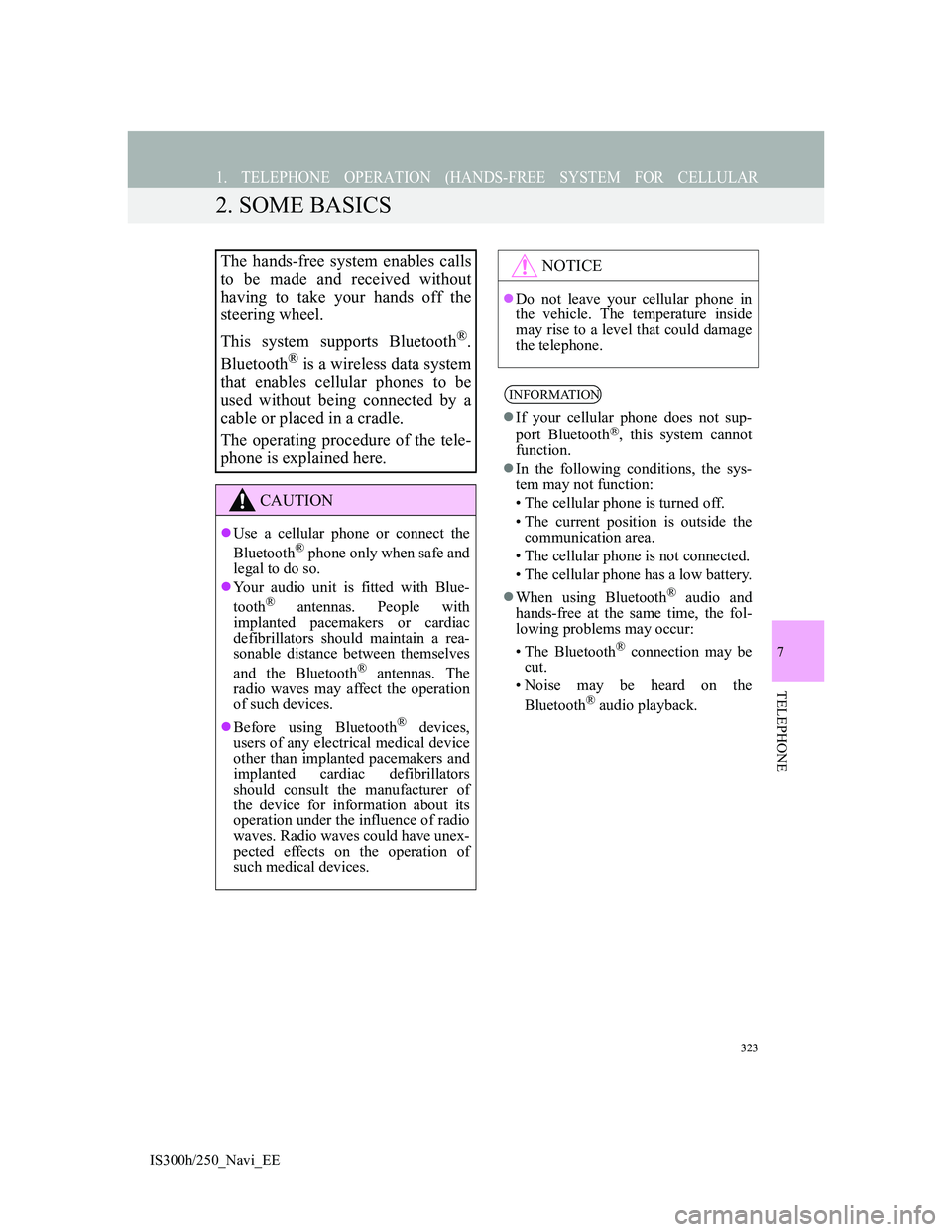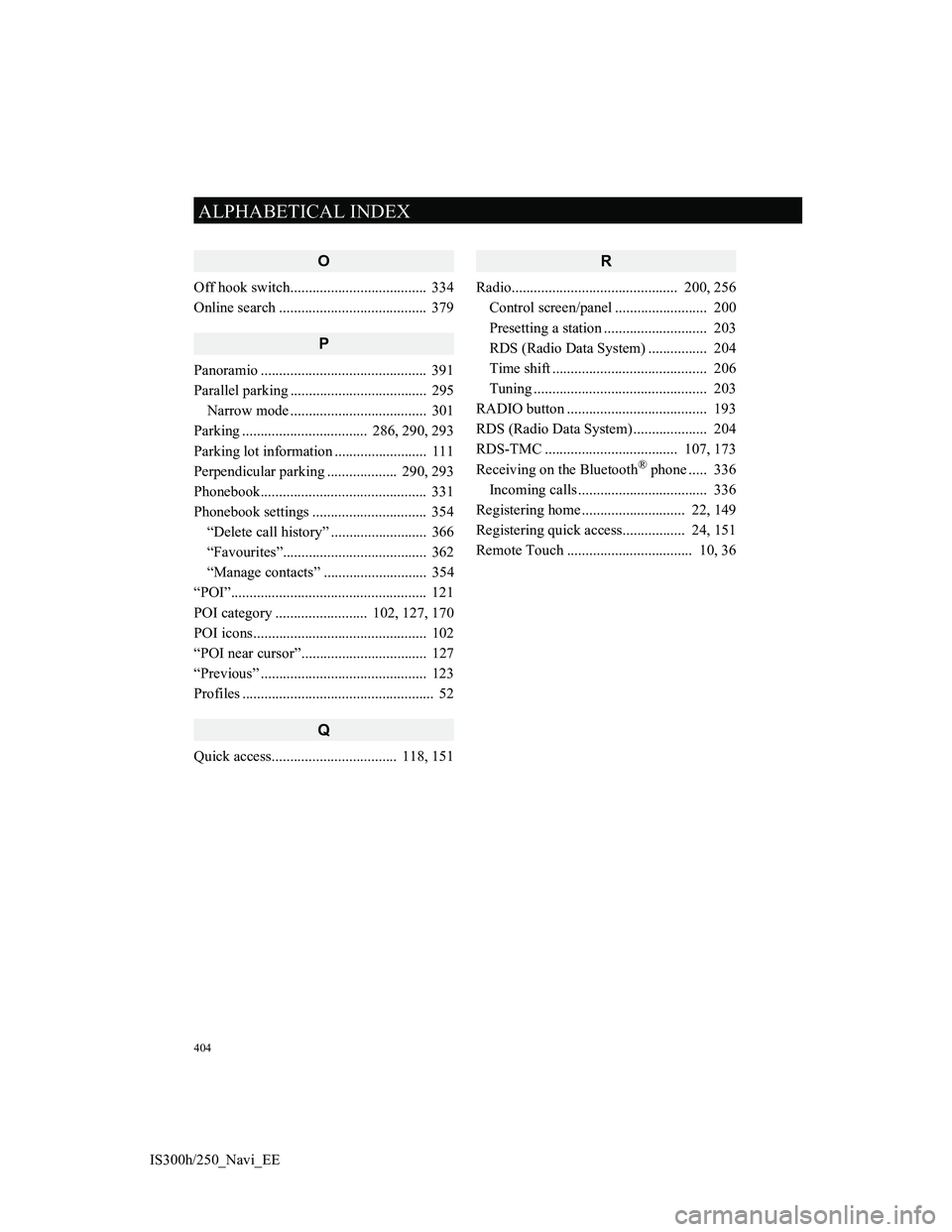2013 Lexus IS300h radio
[x] Cancel search: radioPage 257 of 415

257
6. TIPS FOR OPERATING THE AUDIO/VISUAL SYSTEM
4
AUDIO/VIDEO SYSTEM
IS300h/250_Navi_EE
Fading and drifting stations: Generally,
the effective range of FM is about 25
miles (40 km). Once outside this range,
you may notice fading and drifting,
which increase with the distance from
the radio transmitter. They are often ac-
companied by distortion.
Multi-path: FM signals are reflective,
making it possible for 2 signals to reach
the vehicle’s antenna at the same time.
If this happens, the signals will cancel
each other out, causing a momentary
flutter or loss of reception.
Static and fluttering: These occur when
signals are blocked by buildings, trees
or other large objects. Increasing the
bass level may reduce static and flutter-
ing.
Station swapping: If the FM signal be-
ing listened to is interrupted or weak-
ened, and there is another strong station
nearby on the FM band, the radio may
tune in the second station until the orig-
inal signal can be picked up again.Fading: AM broadcasts are reflected by
the upper atmosphere — especially at
night. These reflected signals can inter-
fere with those received directly from
the radio station, causing the radio sta-
tion to sound alternately strong and
weak.
Station interference: When a reflected
signal and a signal received directly
from a radio station are very nearly the
same frequency, they can interfere with
each other, making it difficult to hear
the broadcast.
Static: AM is easily affected by external
sources of electrical noise, such as high
tension power lines, lightening or elec-
trical motors. This results in static.
FMAM
Page 316 of 415

314
2. LEXUS PARKING ASSIST-SENSOR
IS300h/250_Navi_EE
Approximately 1.6 ft. (50 cm)
Approximately 2.0 ft. (60 cm)
Approximately 3.3 ft. (100 cm)
Approximately 4.9 ft. (150 cm)
The diagram shows the detection range
of the sensors. Note that the sensors
cannot detect obstacles that are
extremely close to the vehicle.
The range of the sensors may change
depending on the shape of the object
etc.There is dirt, snow or ice on a sensor.
A sensor is frozen.
A sensor is covered in any way.
The vehicle is leaning considerably to
one side.
On an extremely bumpy road, on an
incline, on gravel, or on grass
The vicinity of the vehicle is noisy due
to vehicle horns, motorcycle engines,
air brakes of large vehicles, or other
loud noises producing ultrasonic
waves.
There is another vehicle equipped with
parking assist-sensors in the vicinity.
A sensor is coated with a sheet of spray
or heavy rain.
The vehicle is equipped with a fender
pole or radio antenna.
Towing eyelets are installed.
A bumper or sensor receives a strong
impact.
The vehicle is approaching a tall or
right-angled curb.
In harsh sunlight or intense cold
weather.
A non-genuine Lexus suspension (low-
ered suspension etc.) is installed.
DETECTION RANGE OF THE
SENSORSSENSOR DETECTION
INFORMATION
Certain vehicle conditions and the
surrounding environment may affect
the ability of a sensor to correctly de-
tect an obstacle. Particular instances
where this may occur are listed be-
low.
In addition to the examples above,
there are instances in which, because
of their shapes, signs and other
objects may be judged by a sensor to
be closer than they are.
Page 325 of 415

323
1. TELEPHONE OPERATION (HANDS-FREE SYSTEM FOR CELLULAR
IS300h/250_Navi_EE
7
TELEPHONE
2. SOME BASICS
The hands-free system enables calls
to be made and received without
having to take your hands off the
steering wheel.
This system supports Bluetooth
®.
Bluetooth
® is a wireless data system
that enables cellular phones to be
used without being connected by a
cable or placed in a cradle.
The operating procedure of the tele-
phone is explained here.
CAUTION
Use a cellular phone or connect the
Bluetooth® phone only when safe and
legal to do so.
Your audio unit is fitted with Blue-
tooth
® antennas. People with
implanted pacemakers or cardiac
defibrillators should maintain a rea-
sonable distance between themselves
and the Bluetooth
® antennas. The
radio waves may affect the operation
of such devices.
Before using Bluetooth
® devices,
users of any electrical medical device
other than implanted pacemakers and
implanted cardiac defibrillators
should consult the manufacturer of
the device for information about its
operation under the influence of radio
waves. Radio waves could have unex-
pected effects on the operation of
such medical devices.
NOTICE
Do not leave your cellular phone in
the vehicle. The temperature inside
may rise to a level that could damage
the telephone.
INFORMATION
If your cellular phone does not sup-
port Bluetooth®, this system cannot
function.
In the following conditions, the sys-
tem may not function:
• The cellular phone is turned off.
• The current position is outside the
communication area.
• The cellular phone is not connected.
• The cellular phone has a low battery.
When using Bluetooth
® audio and
hands-free at the same time, the fol-
lowing problems may occur:
• The Bluetooth
® connection may be
cut.
• Noise may be heard on the
Bluetooth
® audio playback.
Page 375 of 415

372
3. WHAT TO DO IF...
IS300h/250_Navi_EE
: For details, refer to the owner’s manual that came with the cellular phone.
Even though all
conceivable mea-
sures have been
taken, the symptom
status does not
change.
The cellular phone
is not close enough
to this system.Bring the cellular
phone closer to this
system.
Radio interference
has occurred.Turn off Wi-Fi®
devices or other de-
vices that may emit
radio waves.
The cellular phone
is the most likely
cause of the symp-
tom.
Turn the cellular
phone off, remove
and reinstall the
battery pack, and
then restart the cel-
lular phone.
Enable the cellular
phone’s
Bluetooth
® con-
nection.
Disable the Wi-Fi®
connection of the
cellular phone.
Stop the cellular
phone’s security
software and close
all applications.
Before using an ap-
plication installed
on the cellular
phone, carefully
check its source
and how its opera-
tion might affect
this system.
SymptomLikely causeSolution
Page
Cellular
phoneThis
system
Page 401 of 415

398
ALPHABETICAL INDEX
IS300h/250_Navi_EE
A
AAC ...................................... 207, 264, 266
Adding destinations .............................. 143
“Address” .............................................. 118
AF (Alternative frequency) ........... 204, 248
AM ........................................................ 200
Area to avoid ......................................... 160
Arrival time ........................................... 135
Audio..................................................... 190
Audio screen adjustment ................... 198
Basic operation .................................. 192
Disc slot ............................................. 194
Selecting an audio source .................. 193
Sound settings.................................... 196
Speech command system................... 199
System on/off .................................... 192
USB/AUX port .................................. 195Audio settings ....................................... 246
Audio/visual operating information ..... 256
DVD player and disc......................... 258
Error messages .................................. 268
File (audio) ........................................ 264
iPod ................................................... 263
Radio ................................................. 256
Terms ................................................ 266
AUX ..................................................... 238
Control screen/panel ......................... 238
AUX port ...................................... 195, 238
Average speed ...................................... 170
Page 407 of 415

404
ALPHABETICAL INDEX
IS300h/250_Navi_EE
O
Off hook switch..................................... 334
Online search ........................................ 379
P
Panoramio ............................................. 391
Parallel parking ..................................... 295
Narrow mode ..................................... 301
Parking .................................. 286, 290, 293
Parking lot information ......................... 111
Perpendicular parking ................... 290, 293
Phonebook............................................. 331
Phonebook settings ............................... 354
“Delete call history” .......................... 366
“Favourites”....................................... 362
“Manage contacts” ............................ 354
“POI”..................................................... 121
POI category ......................... 102, 127, 170
POI icons............................................... 102
“POI near cursor”.................................. 127
“Previous” ............................................. 123
Profiles .................................................... 52
Q
Quick access.................................. 118, 151
R
Radio............................................. 200, 256
Control screen/panel ......................... 200
Presetting a station ............................ 203
RDS (Radio Data System) ................ 204
Time shift .......................................... 206
Tuning ............................................... 203
RADIO button ...................................... 193
RDS (Radio Data System) .................... 204
RDS-TMC .................................... 107, 173
Receiving on the Bluetooth
® phone ..... 336
Incoming calls ................................... 336
Registering home ............................ 22, 149
Registering quick access................. 24, 151
Remote Touch .................................. 10, 36